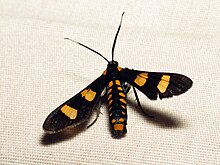Phoenicoprocta hampsonii
Appearance
| Phoenicoprocta hampsonii | |
|---|---|

| |
| Scientific classification | |
| Kingdom: | |
| Phylum: | |
| Class: | |
| Order: | |
| Family: | |
| Subfamily: | |
| Genus: | |
| Species: | P. hampsonii
|
| Binomial name | |
| Phoenicoprocta hampsonii | |
| Synonyms | |
| |
Phoenicoprocta hampsonii is a moth in the subfamily Arctiinae. It was described by William Barnes in 1904. It is found in the United States in south-eastern Arizona and in Mexico's Baja California.
The length of the forewings is about 17 mm. Adults are on wing from July to September.
Etymology
The species is named in honor of lepidopterist Sir George F. Hampson.[3]
References
- ^ "930468.00 – 8285 – Phoenicoprocta hampsonii – (Barnes, 1904)". North American Moth Photographers Group. Mississippi State University. Retrieved June 8, 2019.
- ^ Savela, Markku. "Syntomeida Harris, 1839". Lepidoptera and Some Other Life Forms. Retrieved September 21, 2017.
- ^ Heiman, Maury J. (August 17, 2018). "Species Phoenicoprocta hampsonii - Hodges#8285". BugGuide. Retrieved June 8, 2019.
- Pitkin, Brian & Jenkins, Paul. "Search results Family: Arctiidae". Butterflies and Moths of the World. Natural History Museum, London.
